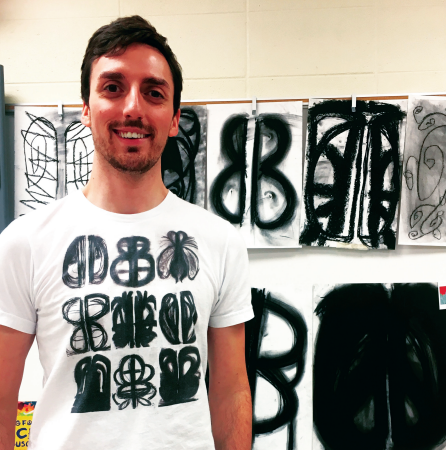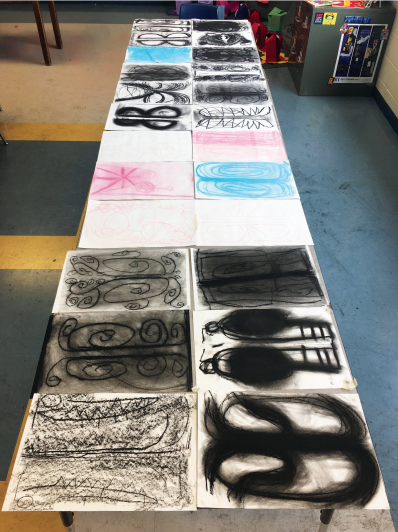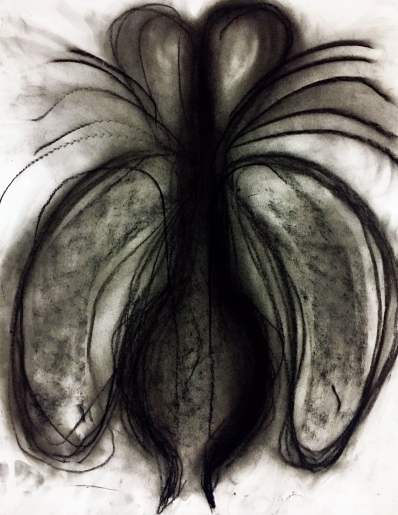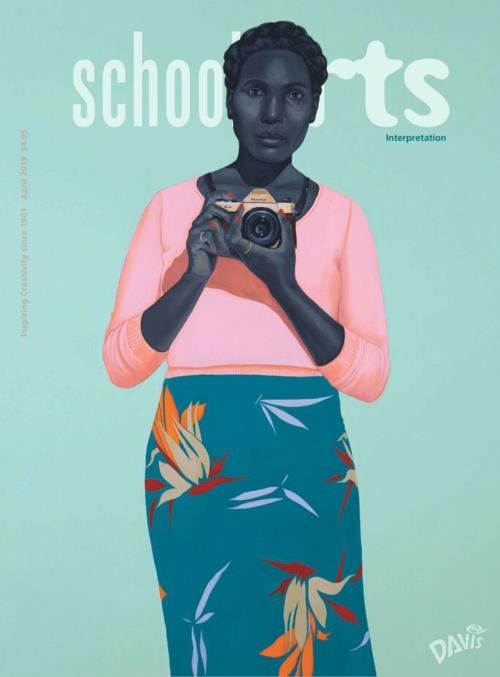
Art teacher Jordan DeWilde proudly wears a t-shirt featuring nine of students’ artworks.
Inspired by Heather Hansen
I was first introduced to artist and dancer Heather Hansen by my former classmate, Kim St. Leger (@artasticABSTRACT Jordan DeWilde MARK MAKING gws), and later by my student teacher, Johannah Tomita (@ms.tomita.art). Both of these women are phenomenal art teachers and provide great examples of contemporary art in their classrooms. Each had approached interpreting and teaching Hansen in different ways, and I decided to put my own spin on the artist to add something new to my third-grade curriculum.
 Students’ Hansen-inspired artworks.
Students’ Hansen-inspired artworks.
The First Class
We started our unit with a time-lapse video I found on YouTube of Hansen creating her large-scale abstract drawings. She uses a full range of motion with charcoal in each hand to create symmetrical marks on large paper. After watching the video, I gave students each a sheet of copy paper and asked them to choose two of the same art materials: colored pencils, markers, crayons, etc., and mirror Hansen’s style by using both hands to make simultaneous and symmetrical marks.
At first, students struggled. Many didn’t understand that their marks didn’t need to look like a specific subject. Some students tried to use Hansen’s methods to create flowers, faces, or peace signs, rather than letting their movements create something organic. At the end of the first day, I identified a few students who were on the right track. We discussed representational versus abstract and deliberate mark making compared to scribbling. After the first day, I was not sure how well the direction of this project was going, but students’ discussions about the process had been productive, so I was encouraged to move forward.
 Lauren Weems, grade three.
Lauren Weems, grade three.
The Second Class
The next day, I gave each student an 18 x 24" (46 x 61 cm) sheet of paper and two sticks of charcoal. I have six tables in my artroom and only one student worked at each table at a time. Six at a time, students finished their drawings, then placed the finished artwork on a stack at the front of the room and returned to their table to watch and encourage the rest of their classmates.
I circled the room, pointing out when students needed to slow down or work with both hands, or that they were getting too wild with scribbles and not focused on deliberate mark making. By the end of class, most students were catching on. I saw fewer attempts at making a subject and many successful abstract compositions. I was proud of students’ work and excited to continue with the next class.
The Third Class
On our third day, I gave students each a 12 x 18 " (30 x 46 cm) sheet of paper and asked them to once more create using the artist’s style. Students experimented more with the charcoal after seeing the work of their peers. Some were interested in blending the charcoal, while others used more line variety. The work improved and I noticed few students struggling.
A Collaborative Drawing Game
For our final day of this unit, I asked students to partner up for a Hansen inspired drawing game. Students taped their papers down across from one another, and I asked them to mimic the movements of their partner. When their partner made two large spirals, they were to follow their lead and create them simultaneously. The task was a little challenging at first, with students working out of synch and getting frustrated. They eventually figured out a rhythm and created beautiful works of art. From the four days studying Hansen’s art, students created their own artwork using a variety of paper sizes and art media. I asked students to choose one of their artworks that best represented their understanding of Hansen’s art. I assessed the work based on symmetry and abstraction. Almost every student was able to turn in an artwork that demonstrated these concepts.
Responses
I sprayed select works with fixative and hung them in our school library for display. I was extremely pleased with how well students had done and surprised by the positive reactions from my colleagues. I would not have guessed they would respond so well to these abstract works, but they received some of the highest praise of the year! I photographed students’ artwork and designed a t-shirt featuring nine of their artworks. They were blown away when I wore it to class. I told them how proud I was of their creations, and that I wanted to add them to my #ArtShirtFriday collection of great artworks!
Jordan DeWilde is an art teacher at Oregon Elementary School in Oregon, Illinois. JordanDeWilde@Gmail.com
NATIONAL STANDARD
Creating: Organize and develop new artistic ideas and work.
View this article in the digital edition.



 Students’ Hansen-inspired artworks.
Students’ Hansen-inspired artworks. Lauren Weems, grade three.
Lauren Weems, grade three.